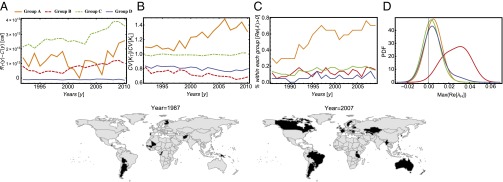ENVIRONMENTAL SCIENCES Correction for “Resilience and reactivity of global food security,” by Samir Suweis, Joel A. Carr, Amos Maritan, Andrea Rinaldo, and Paolo D’Odorico, which appeared in issue 22, June 2, 2015, of Proc Natl Acad Sci USA (112:6902–6907; first published May 11, 2015; 10.1073/pnas.1507366112).
The authors note that Fig. 3 and its corresponding legend appeared incorrectly. The corrected figure and its corrected legend appear below.
Fig. 3.

(A) Total food excess (in calories) calculated as the sum of the difference between supply (through production and trade) and consumption for all countries in each group, g (i.e., , where cali is the average daily per-capita diet of country i and xi is its population). (B) Ratio of the coefficients of variation (i.e., SD: mean) of food production (KL) and trade-dependent supply (KT) for each country group as a function of time. (C) Fraction of most sensitive (i.e., unstable) countries within each group for different years. (D) Distribution of the most reactive countries [given by Max(Re(λH))] for the four groups, considering all years from 1986 to 2010. Food trade-dependent countries (group B) are on average more reactive than group A, C, and D nations. (Lower) Map of reactive countries (see also Fig. S3 for most unstable countries) for two different years (1987 and 2008). All calculation have been done with a delay τ = 1 y.
The authors also note that on page 6905, left column, first paragraph, lines 15–19 “countries from groups B and C appear to be more prone to instability than self-sufficient countries from group A (Fig. 3 C and D). This result suggests that food insecurity is increasing worldwide and trade-dependent countries are particularly vulnerable to food crises” should instead appear as “countries from groups A and B appear to be more prone to instability (Fig. 3 C and D). These results suggest that long-term food insecurity is increasing worldwide and also affecting self-sufficient (group A) countries. Trade-dependent countries are particularly vulnerable to food crises (Fig. 3D).” These errors do not affect the conclusions of the article.


